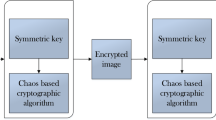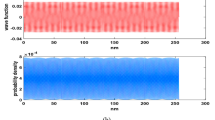Abstract
In this paper, a new medical image encryption system is proposed using a special nonlinear filter function based linear feedback shift register (LFSR). This special nonlinear filter function based LFSR is used as a pseudo-random number generator (PRNG). In this generator, word-based effective operation has been applied to speed up the process of encryption and decryption. Firstly, the medical image is randomized by Logistic-Tent map and scrambled by Arnold transformation method. Next, the disordered image data is XORed with output sequences of specially designed PRNG to obtain cipher image. Our designed structure aims to provide high-level randomness in the cipher image content. Encryption decryption time requirements reveal the efficiency of the proposed system. Several performance measures are estimated to validate the resistance of the proposed scheme against statistical, differential, and a few common cryptanalytic attacks. The proposed encryption scheme compares favorably with several existing image encryption schemes.







Similar content being viewed by others
References
Alvarez G, Li S (2006) Some basic cryptographic requirements for chaos-based cryptosystems. Int J Bifurc Chaos 16(08):2129–2151
Belazi A, Khan M, El-Latif AAA, Belghith S (2017) Efficient cryptosystem approaches: S-boxes and permutation–substitution-based encryption. Nonlinear Dyn 87(1):337–361
Bishoi SK, Haran HK, Hasan SU (2017) A note on the multiple-recursive matrix method for generating pseudorandom vectors. Discrete Appl Math 222:67–75
Burnett L, Millan W, Dawson E, Clark A (2004) Simpler methods for generating better Boolean functions with good cryptographic properties. Australas J Comb 29:231–248
Chai X, Yang K, Gan Z (2017) A new chaos-based image encryption algorithm with dynamic key selection mechanisms. Multimed Tools Appl 76(7):9907–9927
Chai X, Fu X, Gan Z, Lu Y, Chen Y (2019) A color image cryptosystem based on dynamic DNA encryption and chaos. Signal Process 155:44–62
Chai X, Gan Z, Yuan K, Chen Y, Liu X (2019) A novel image encryption scheme based on DNA sequence operations and chaotic systems. Neural Comput Appl 31(1):219–237
Dagadu JC, Li JP, Aboagye EO (2019) Medical image encryption based on hybrid chaotic DNA diffusion. Wirel Pers Commun 108(1):591–612
Das P, Deb S, Kar N, Bhattacharya B (2015) An Improved DNA based dual cover steganography. Procedia Comput Sci 46:604–611
Deb S, Bhuyan B, Gupta NC (2018) Design and analysis of LFSR-based stream cipher. In: Proceedings of the international conference on computing and communication systems. Springer, pp 631–639
Deb S, Biswas B, Bhuyan B (2019) Secure image encryption scheme using high efficiency word-oriented feedback shift register over finite field. Multimed Tools Appl 78(24):34901–34925
Dong C (2015) Asymmetric color image encryption scheme using discrete-time map and hash value. Optik 126(20):2571–2575
Fan H, Li M (2017) Cryptanalysis and improvement of chaos-based image encryption scheme with circular inter-intra-pixels bit-level permutation. Math Probl Eng 2017:1–11. https://doi.org/10.1155/2017/8124912
Filiol E, Fontaine C (1998) Highly nonlinear balanced Boolean functions with a good correlation-immunity. In: International conference on the theory and applications of cryptographic techniques. Springer, pp 475–488
Gan ZH, Chai XL, Han DJ, Chen YR (2019) A chaotic image encryption algorithm based on 3-D bit-plane permutation. Neural Comput Appl 31 (11):7111–7130
Jolfaei A, Vizandan A, Mirghadri A (2012) Image encryption using HC-128 and HC-256 stream ciphers. Int J Electr Secur Digit Forensics 4(1):19–42
Kadir A, Hamdulla A, Guo WQ (2014) Color image encryption using skew tent map and hyper chaotic system of 6th-order CNN. Optik-Int J Light Electron Opt 125(5):1671–1675
Khan M, Shah T (2014) A novel image encryption technique based on Hénon chaotic map and S8 symmetric group. Neural Comput Appl 25(7-8):1717–1722
Kumar P, Rana SB (2016) Development of modified AES algorithm for data security. Optik-Int J Light Electron Opt 127(4):2341–2345
Kumari M, Gupta S (2018) A novel image encryption scheme based on intertwining chaotic maps and RC4 stream cipher. 3D Res 9(1):10
Kumar S, Panna B, Jha RK (2019) Medical image encryption using fractional discrete cosine transform with chaotic function. Med Biol Eng Comput 57 (11):2517–2533
Laiphrakpam DS, Khumanthem MS (2017) Medical image encryption based on improved ElGamal encryption technique. Optik 147:88–102
Laiphrakpam DS, Khumanthem MS (2018) A robust image encryption scheme based on chaotic system and elliptic curve over finite field. Multimed Tools Appl 77(7):8629–8652
Li B, Liao X, Jiang Y (2019) A novel image encryption scheme based on improved random number generator and its implementation. Nonlinear Dyn 95(3):1781–1805
Liang Y, He F, Zeng X (2020) 3D mesh simplification with feature preservation based on whale optimization algorithm and differential evolution. Integr Comput-Aided Eng (Preprint):1–19
Lima JB, Madeiro F, Sales FJ (2015) Encryption of medical images based on the cosine number transform. Signal Process: Image Commun 35:1–8
Liu H, Kadir A (2015) Asymmetric color image encryption scheme using 2D discrete-time map. Signal Process 113:104–112
Liu W, Sun K, Zhu C (2016) A fast image encryption algorithm based on chaotic map. Opt Lasers Eng 84:26–36
Maddodi G, Awad A, Awad D, Awad M, Lee B (2018) A new image encryption algorithm based on heterogeneous chaotic neural network generator and dna encoding. Multimed Tools Appl 77(19):24701–24725
Maitra S (2011) Boolean functions: cryptographic and combinatorial properties: functions with symmetry. World Scientific
Maitra S, Mandal B, Martinsen T, Roy D, Stănică P (2019) Analysis on Boolean function in a restricted (biased) domain. IEEE Trans Inf Theory 66(2):1219–1231
Mondal B, Kumar P, Singh S (2018) A chaotic permutation and diffusion based image encryption algorithm for secure communications. Multimed Tools Appl 77(23):31177–31198
Murcia G, Ortíz MJ, López-Gordo M, Ferrández JM, Sánchez Ferrer F, Fernández E (2019) Neural representation of different 3D architectural images: an EEG study. Integr Comput-Aided Eng 26(2):197–205
Özkaynak F (2019) Construction of robust substitution boxes based on chaotic systems. Neural Comput Appl 31(8):3317–3326
Praveenkumar P, Devi N K, Ravichandran D, Avila J, Thenmozhi K, Rayappan JBB, et al. (2018) Transreceiving of encrypted medical image–a cognitive approach. Multimed Tools Appl 77(7):8393–8418
Rukhin A, Soto J, Nechvatal J, Smid M, Barker E (2001) A statistical test suite for random and pseudorandom number generators for cryptographic applications. National Institute of Standards and Technology
Shah T, Hussain I, Gondal MA, Mahmood H (2011) Statistical analysis of S-box in image encryption applications based on majority logic criterion. Int J Phys Sci 6(16):4110–4127
Stalin S, Maheshwary P, Shukla PK, Maheshwari M, Gour B, Khare A (2019) Fast and secure medical image encryption based on non linear 4D logistic map and DNA sequences (NL4DLM_DNA). J Med Syst 43(8):267
Ullah A, Jamal SS, Shah T (2018) A novel scheme for image encryption using substitution box and chaotic system. Nonlinear Dyn 91(1):359–370
Wong K, Yap W, Goi B, Wong DC (2019) Differential cryptanalysis on chaotic based image encryption scheme. In: IOP conference series: materials science and engineering, vol 495. IOP Publishing, p 012041
Wu Y, He F, Zhang D, Li X (2015) Service-oriented feature-based data exchange for cloud-based design and manufacturing. IEEE Trans Serv Comput 11(2):341–353
Xia Z, Wang X, Zhou W, Li R, Wang C, Zhang C (2019) Color medical image lossless watermarking using chaotic system and accurate quaternion polar harmonic transforms. Signal Process 157:108–118
Zeng G, Han W, He K (2007) High efficiency feedback shift register: σ −LFSR. https://eprint.iacr.org/2007/114. Cryptology ePrint Archive, Report 2007/114
Zhang X, Zhao Z, Wang J (2014) Chaotic image encryption based on circular substitution box and key stream buffer. Signal Process: Image Commun 29(8):902–913
Zhou Y, Bao L, Chen CP (2014) A new 1D chaotic system for image encryption. Signal Process 97:172–182
Author information
Authors and Affiliations
Corresponding author
Additional information
Publisher’s note
Springer Nature remains neutral with regard to jurisdictional claims in published maps and institutional affiliations.
Rights and permissions
About this article
Cite this article
Deb, S., Bhuyan, B. Chaos-based medical image encryption scheme using special nonlinear filtering function based LFSR. Multimed Tools Appl 80, 19803–19826 (2021). https://doi.org/10.1007/s11042-020-10308-7
Received:
Revised:
Accepted:
Published:
Issue Date:
DOI: https://doi.org/10.1007/s11042-020-10308-7




